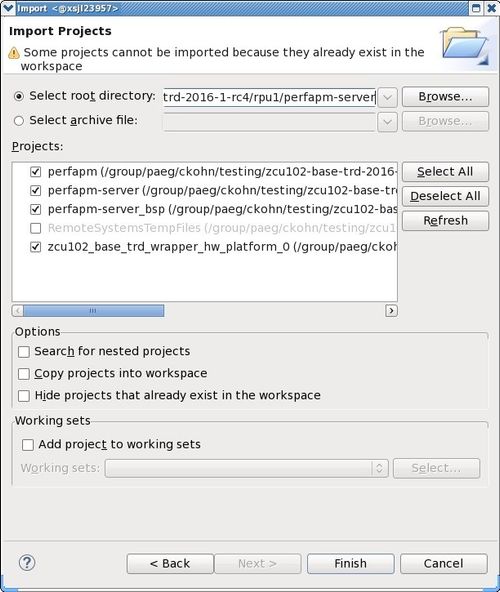Zynq UltraScale+ MPSoC Base TRD 2019.1 - Design Module 4
Table of Contents
Design Overview
This module demonstrates:
- Boot RPU1 from APU master via remoteproc
- Inter Process Communication (IPC)
- APU master: RPMsg
- RPU1 remote: OpenAMP
- RPU1 Bare-metal application (server)
- Reads performance counters and sends to APU
- APU Linux application (client)
- Receives performance counters from RPU1 and prints to UART0
Design Components
This module requires the following components:
- petalinux_bsp
- perfapm-server
- perfapm-client-test
Build Flow Tutorials
This tutorial uses both XSDK and PetaLinux tools. It is recommended to use separate shells for each of the tools.
Perfapm-server Application
The performance monitor server application
perfapm-server is a bare-metal application that executes on RPU-1. The firmware binary is loaded by the APU master at the end of the Linux boot process. RPU-1 and APU establish a communication channel using the OpenAMP framework. RPU-1 gathers performance data like memory throughput from the PS AXI performance monitor (APM) units and sends it across to the APU where the data is received by the perfapm-client library and then visualized on a plotted graph.Create a new XSDK workspace.
% cd $TRD_HOME/workspaces/ws_perfapm-server % xsdk -workspace . &
- Click 'Import Project' from the welcome screen, browse to the current working directory and make sure the
perfapm,perfapm-server,perfapm_bsp, andhw_platform_0projects are selected. Click 'Finish'. - Right-click on the
perfapm-serverproject and select 'Build Project'. Copy the generated
perfapm-serverexecutable to the dm4 SD card directory.% mkdir -p $TRD_HOME/sd_card/dm4 % cp perfapm-server/Debug/perfapm-server.elf $TRD_HOME/sd_card/dm4/
Perfapm-client-test Application (optional step)
The
perfapm-client-test application receives performance counter values from RPU-1 and prints them to UART-0. It is by default built as part of the meta-user layer of the PetaLinux BSP. The corresponding yocto recipe and source files are located at $TRD_HOME/petalinux/bsp/project-spec/meta-user/recipes-apps/perfapm-client and the generated binary is located at /usr/bin/perfapm-client-test on the target rootfs.- Make sure you have sourced the SDX
settings64.shscript before executing the below steps. This will add the ARM cross-compile toolchain to yourPATHand set theXILINX_SDXenvironment variable. Copy and extract the source files into a new workspace.
% mkdir -p $TRD_HOME/workspaces/ws_perfapm-client % cd $TRD_HOME/workspaces/ws_perfapm-client % cp $TRD_HOME/petalinux/bsp/project-spec/meta-user/recipes-apps/perfapm-client/files/perfapm-client.zip . % unzip perfapm-client.zip % mkdir build work
Configure the project using
cmakeand generate eclipse project files. Build the project usingmakefrom the command line.- Source the PetaLinux SDK environment setup script which sets the
SDKTARGETSYSROOTenvironment variable which contains the target and host sysroot for building this application. This requires to complete the PetaLinux SDK installation step as described in Design Module 5.% cd build % CC=aarch64-linux-gnu-gcc CXX=aarch64-linux-gnu-g++ \ cmake -G"Eclipse CDT4 - Unix Makefiles" -DCMAKE_ECLIPSE_EXECUTABLE=${XILINX_SDX}/eclipse/lnx64.o/eclipse \ ../src % make -j Alternatively you can build the project through the XSDK GUI.
% cd ../work % xsdk -workspace . &
- Click 'Import Project' from the welcome screen, browse to the
$TRD_HOME/workspaces/ws_perfapm-client/builddirectory and make sure the listed project is selected. Click 'Finish'. - Right-click the project and select 'Build Project'.
Copy the generated
perfapm-client-testexecutable to the dm4 SD card directory.% cp $TRD_HOME/workspaces/ws_perfapm-client/build/perfapm-client-test/perfapm-client-test $TRD_HOME/sd_card/dm4
PetaLinux BSP
This tutorial shows how to build the Linux image and boot image using the PetaLinux build tool. This step assumes you have run through the PetaLinux config in DM1 previously.
Select the device-tree matching design module 4 and build all Linux image components. If you have run
petalinux-buildin a previous module, the build step will be incremental.% cd $TRD_HOME/petalinux/bsp/project-spec/meta-user/recipes-bsp/device-tree/files/ % cp zcu102-base-dm4.dtsi system-user.dtsi % petalinux-build
Create a boot image
% cd $TRD_HOME/petalinux/bsp/images/linux % petalinux-package --boot --bif=../../project-spec/boot/dm4.bif --force
Copy the generated images to the dm4 SD card directory
% cp BOOT.BIN image.ub $TRD_HOME/sd_card/dm4
Run Flow Tutorial
- See here for board setup instructions.
- Copy all the files from the
$TRD_HOME/sd_card/dm4SD card directory to a FAT formatted SD card. - Power on the board to boot the images; make sure all power rail LEDs are lit green (Note: DS1 / FPGA_INIT_B LED remains Red as there is no bit stream to configure the FPGA).
Run the
perfapm-client-testapplication:% perfapm-client-test
Below is a sample output of the application on the serial console:
|----------------------------------------------------------------------| | Performance Monitor APP | |----------------------------------------------------------------------| |Slot |Write Byte Cnt |Read Byte Cnt |Total RW Byte Cnt | |----------------------------------------------------------------------| |DDR Slot1 | 62614 | 231056 | 293670 | |DDR Slot2 | 70966 | 327328 | 398294 | |DDR Slot3 | 0 | 994784128 | 994784128 | |DDR Slot4 | 0 | 0 | 0 | |DDR Slot5 | 0 | 0 | 0 | |OCM APM | 64 | 0 | 64 | |LPD_FPD | 1472 | 69728 | 71200 | |----------------------------------------------------------------------| DDRAPM_SLOT_DP+HP0 throughput = 7.958273 gigabits/sec DDRAPM_SLOT_HP1+HP2 throughput = 0.000000 gigabits/sec DDRAPM_SLOT_HP3+FPDDMA throughput = 0.000000 gigabits/sec
Next Steps
- Continue with Design Module 5.
- Return to the Design Tutorials Overview.
© Copyright 2019 - 2022 Xilinx Inc. Privacy Policy


